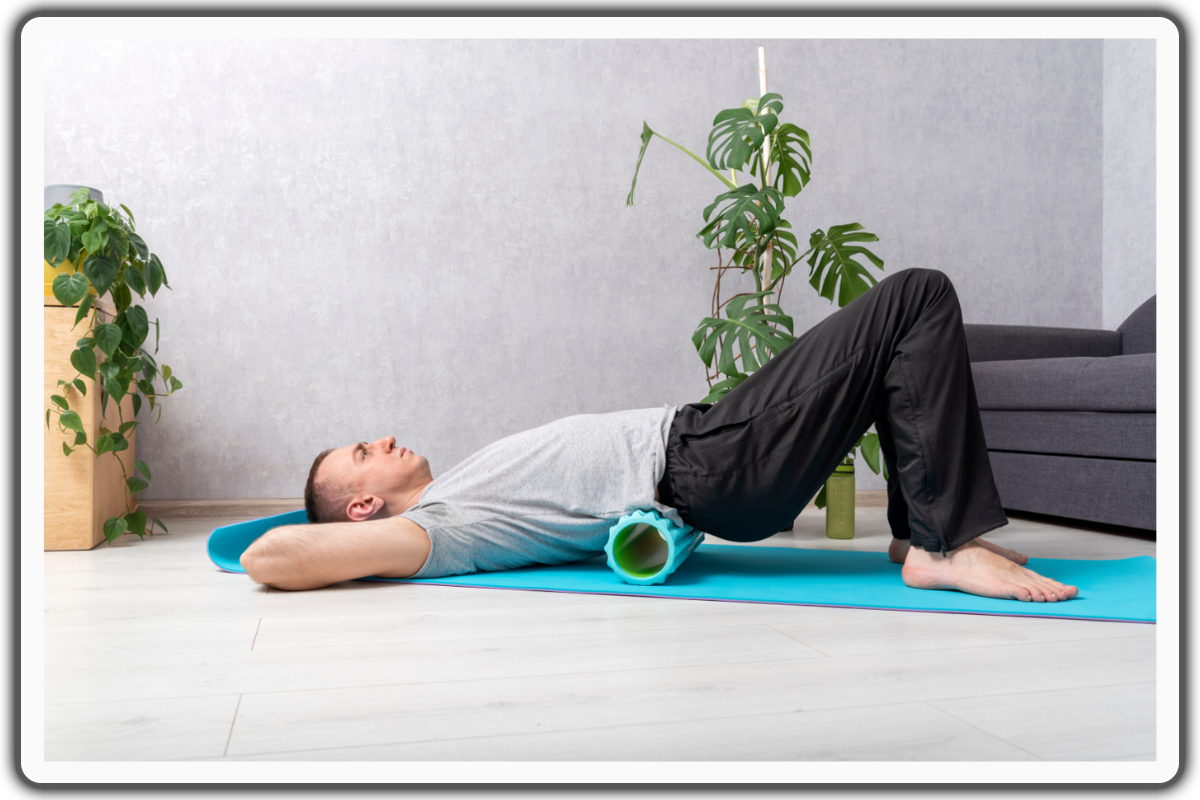
Your Solution to Pain: Foam Roller Exercises Lower Back
Tired of constant lower back pain? Foam roller exercises might be just what you need. This simple method is becoming a favorite for its ability to increase flexibility and ease muscle pain, especially in the lower back.
We'll show you foam roller moves aimed at easing your lower back. These exercises are great for lessening pain and improving how you stand and the health of your spine.
Whether you spend most of your day sitting or always on the go, adding foam roller exercises to your daily routine can change how you feel and move. We'll guide you through each exercise with easy-to-follow steps and tips to ensure you're doing them safely.
Don't let back pain slow you down. Try these foam roller exercises and enjoy a more comfortable, pain-free life.
Understanding Lower Back Pain
Tired of constant lower back pain? Foam roller exercises might be just what you need. This simple method is becoming a favorite for its ability to increase flexibility and ease muscle pain, especially in the lower back.
We'll show you foam roller moves aimed at easing your lower back. These exercises are great for lessening pain and improving how you stand and the health of your spine.
Whether you spend most of your day sitting or always on the go, adding foam roller exercises to your daily routine can change how you feel and move. We'll guide you through each exercise with easy-to-follow steps and tips to ensure you're doing them safely.
Don't let back pain slow you down. Try these foam roller exercises and enjoy a more comfortable, pain-free life.
Understanding Lower Back Pain

Lower back pain is a widespread concern that impacts individuals globally, presenting in various intensities from a mild, continuous ache to severe, life-disrupting agony.
This condition can stem from a myriad of sources, which include but are not limited to:
Muscle or Ligament Strain: Repeated heavy lifting or a sudden awkward movement can strain back muscles and spinal ligaments.
Poor Posture: Long periods of poor posture can contribute significantly to lower back pain.
Spinal Misalignment: Scoliosis or other spinal alignment problems can cause or exacerbate lower back pain.
Herniated or Bulging Discs: The discs act as cushions between your spine's bones (vertebrae). A disc that herniates or bulges can press on a nerve, leading to pain.
Degenerative Disc Disease: This happens when the spinal discs break down, causing pain.
Osteoarthritis: This type of arthritis can affect the lower back, causing the space around the spinal cord to narrow (spinal stenosis).
Osteoporosis: Bones, like the vertebrae of the spine, can become brittle and porous, making compression fractures more likely.
Awareness of the underlying cause of your lower back pain is vital in seeking effective treatment and relief. Seeking guidance from healthcare professionals, like physical therapist or chiropractors, can offer insights into the specific reason for your pain and recommend suitable treatment plans.
Incorporating Foam Roller Exercises for Lower Back Pain Relief
Beyond medical consultation, integrating foam roller exercises into your daily routine is an effective self-care tool for managing lower back pain. Targeting the muscles that support the lower back, foam rolling helps alleviate muscle tension and promote increased blood flow to the affected area. By making foam roller exercises a part of your daily regimen, you can significantly relieve lower back pain symptoms, managing this common yet complex condition overall.
Benefits of Using a Foam Roller for Lower Back Pain

Foam rolling offers numerous benefits for individuals dealing with lower back pain. Here are some of the key advantages:
- Improved Flexibility: Foam rolling helps release tight muscles, increasing your range of motion and flexibility. This can be exceptionally beneficial for individuals with sedentary jobs or those who spend long periods sitting, as it helps counteract the adverse effects of prolonged sitting on the lower back.
Alleviate Muscle Soreness: Foam rolling exercise helps mitigate muscle soreness and stiffness, including delayed onset muscle soreness (DOMS), by enhancing blood circulation to the targeted areas. The boost in blood flow aids in flushing out metabolic waste products, promoting quicker muscle recovery. This process is particularly beneficial for alleviating the discomfort associated with DOMS, which typically emerges after new or intense exercise sessions.
Enhanced Posture: Poor posture is a usual contributor to lower back pain. Foam roller exercises can help improve your posture by loosening tension in the muscles supporting the spine, providing better alignment, and reducing the risk of chronic pain.
Strengthened Core Muscles: Foam roller exercises activate the core muscles, including the deep stabilizing muscles in the lower back. Adding these exercises to your routine can help fortify these muscles, offering improved spinal support and lowering the likelihood of future lower back injuries.
How to Choose the Right Foam Roller
Choosing the right foam roller is crucial to ensure you get the most out of your exercises and avoid potential injuries. Here are some factors to consider when selecting a foam roller:
- Density: Foam rollers come in various densities, ranging from soft to firm. Softer foam rollers provide a gentler massage, while firmer ones offer a more intense pressure. If you're a beginner or have a lower pain tolerance, start with a softer foam roller and gradually progress to firmer ones as your body adjusts.
Size: Foam rollers vary in size, including short and long options. Shorter foam rollers are more portable and easily maneuverable, making them suitable for targeting specific areas like the lower back. Longer foam rollers provide more stability and support, making them ideal for full-body exercises.
Surface Texture: Foam rollers can have different surface textures, such as smooth or textured. Smooth foam rollers provide a more even pressure, while textured foam rollers offer a deeper, more targeted massage. Experiment with different textures to find the most comfortable and effective for your lower back pain relief.
Quality and Durability: Invest in a high-quality foam roller that can withstand repeated use. Cheaper foam rollers may break down quickly, losing their shape and effectiveness. Look for foam rollers made from durable materials that can withstand your body weight and provide long-lasting support.
By considering these factors and choosing a foam roller that suits your needs and preferences, you can optimize the benefits and effectiveness of your lower back foam roller exercises.
Preparing for Foam Roller Exercises
Before starting any new exercise routine, preparing your body properly is vital to minimize the risk of injury. Here are some essential steps to take before engaging in foam roller exercises:
- Warm-up: Start your workout session with a quick warm-up to enhance blood circulation to your muscles and prepare them for the upcoming exercises. Include 5-10 minutes of brisk walking or cycling in your warm-up routine to engage in light cardio exercises.
Stretching: After warming up, perform gentle stretching exercises to loosen up your muscles. Focus on stretching your lower back, hips, and hamstrings, as these areas are commonly affected by lower back pain.
Proper Form: Pay attention to your posture and body alignment during the exercises. Ensure your spine stays neutral and activate your core muscles to provide stability and support. Avoid over-arching or rounding your lower back, as this may strain the muscles and worsen pain.
Breathing: Practice deep, diaphragmatic breathing throughout the exercises. This helps relax your muscles and promotes better oxygenation, enhancing the effectiveness of the foam roller exercises.
By following these preparation steps, you can ensure a safe and effective foam roller exercise session, minimizing the risk of injury and maximizing the benefits of your lower back pain relief.
Best Foam Roller Exercises for Lower Back Pain Relief
Now that you're familiar with the benefits of foam rolling and have prepared your body, it's time to dive into the foam roller exercises specifically targeted for lower back pain relief. These exercises focus on releasing tension, improving mobility, and strengthening the muscles in the lower back. Here are some essential exercises to try:
1- Thoracic Extension Foam Rolling
Lie on your back on the floor with your knees bent and your feet flat on the floor. Lift your upper body and place the foam roller under your upper back, just a few inches below your shoulder blades. Place your hands by your ears or interlace your fingers behind your head to support your neck while maintaining a good alignment with your head, shoulders, and hips. Slowly roll the foam roller from the base of your neck to the bottom of your ribcage, focusing on the thoracic spine area. Repeat the movement. Complete for 1 to 2 sets of 10 repetitions.
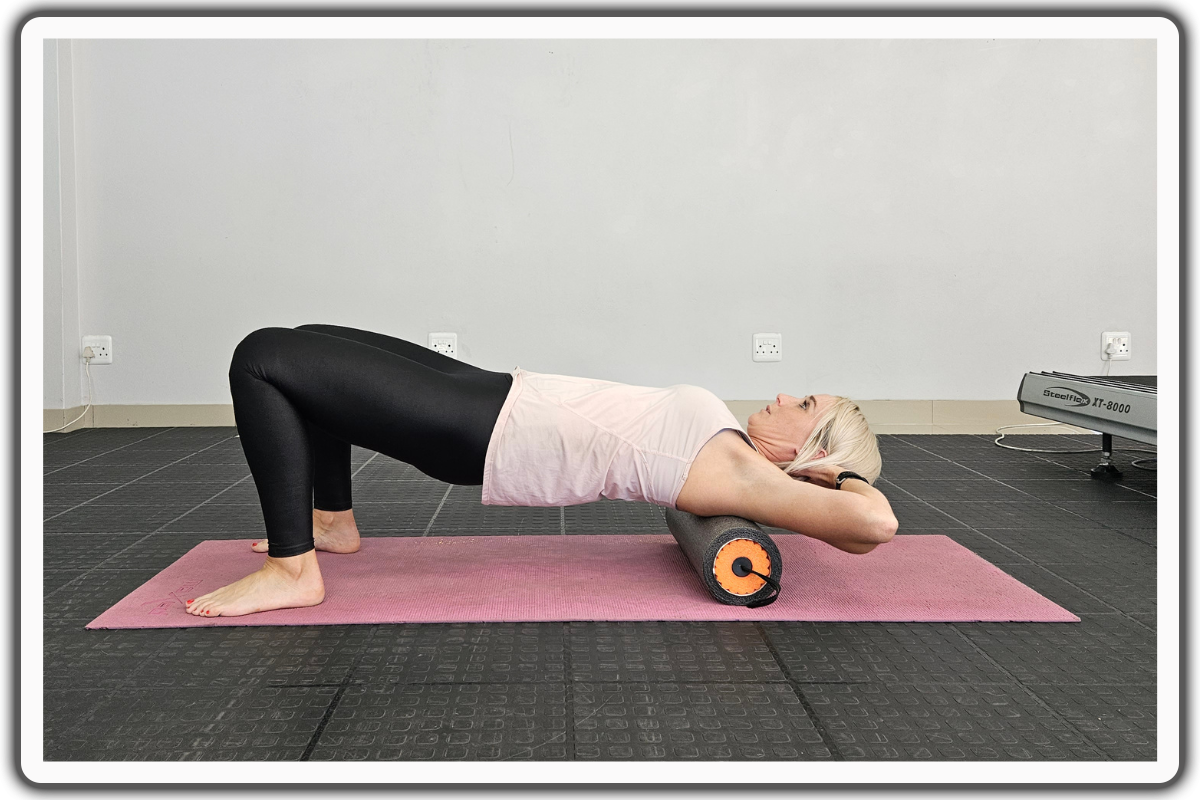
2- Lat Foam Rolling
Lie on the floor with your knees bent and feet flat on the floor. Step your left foot forward and place the foam roller on the outer part of your back. Lift your upper body and maintain good alignment with your head, shoulders, and hips. Engage your core and roll the foam roller from your mid back up to your armpit and back. Repeat the movement. After several repetitions, perform the movement on the opposite side.
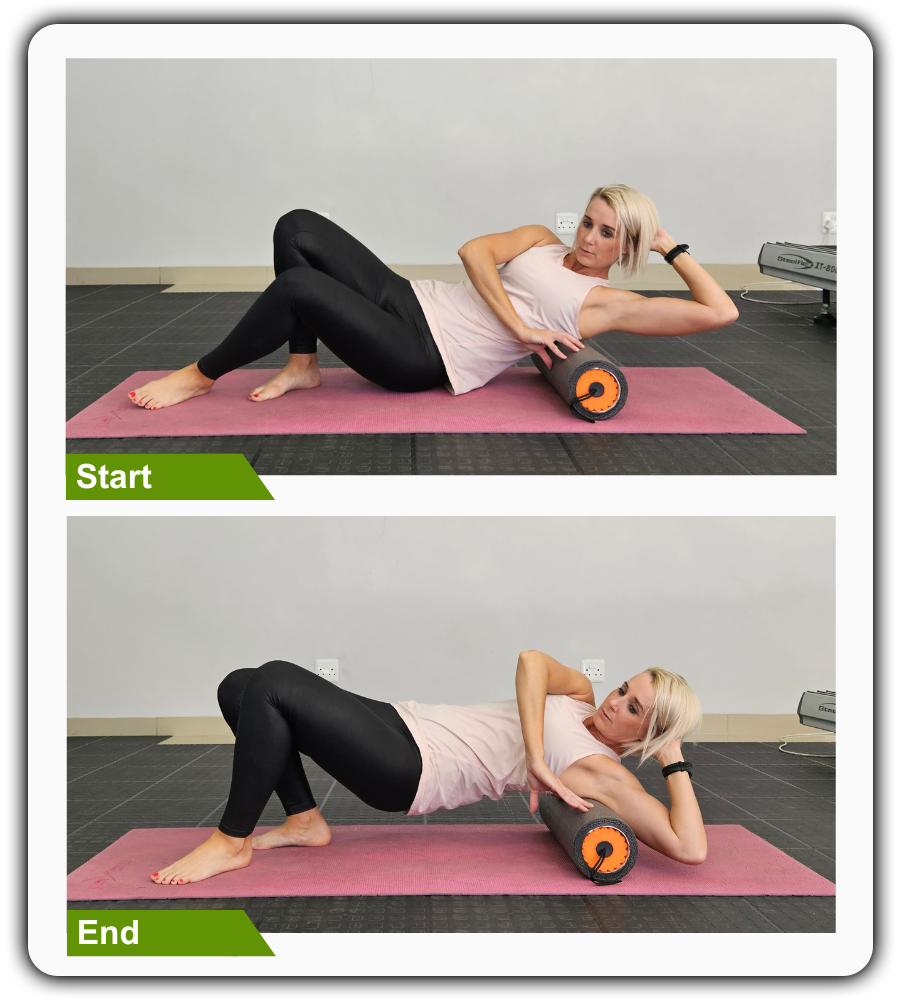
3- Upper Back Foam Rolling
Lie on your back on the floor with your knees bent and your feet flat on the floor. Place the foam roller under your upper back, lifting your upper body and maintaining good alignment with your head, shoulders, and hips. Place your hands by your ears or interlace your fingers behind your head to support your neck. Run the foam roller from your midback to the shoulder blade area and back. Repeat the movement.
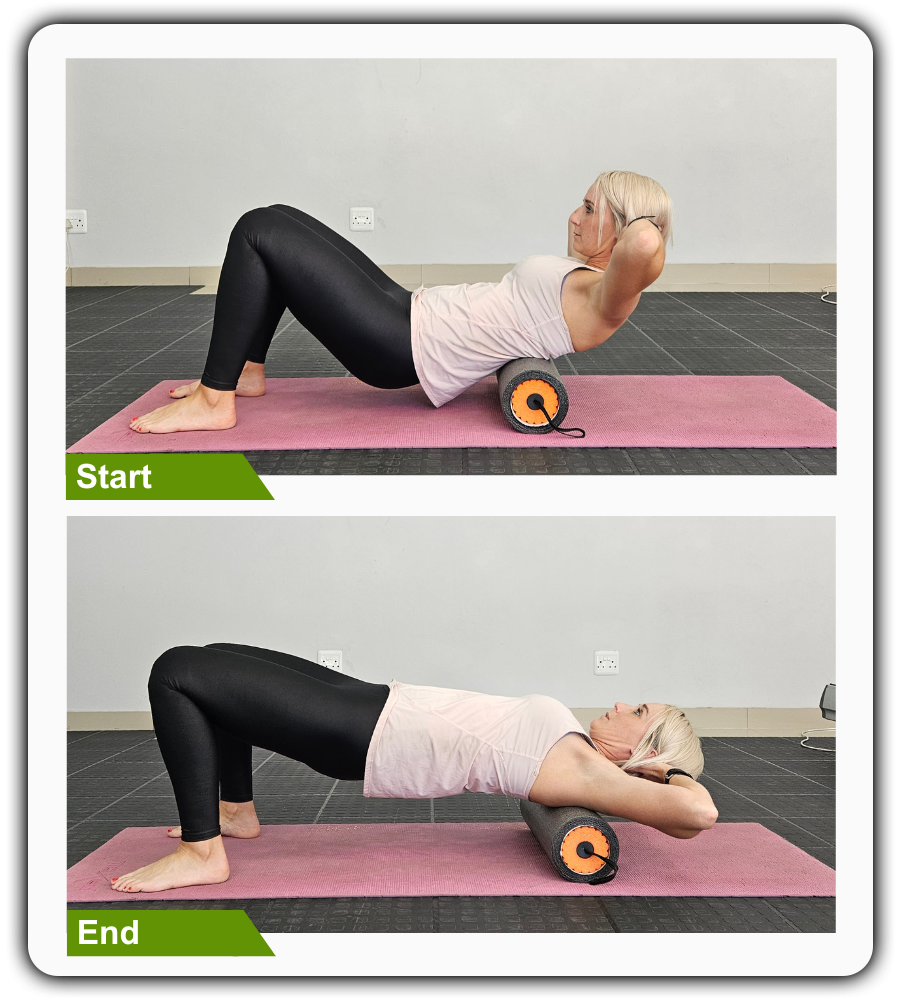
4- Glute Foam Rolling
Sit upright on the floor with your knees bent and your feet flat on the floor, maintaining good alignment with your head, shoulders, and hips. Turn your body to the left side, ideally to a 45-degree angle, and place the foam roller against the side of your glute area. Straighten your left leg and position your left hand behind you for support. Engage your core and roll the foam roller from the bottom of your seat to the top and back. Repeat the movement on the opposite side. Complete for 10 repetitions on each side.
To make the exercise more challenging, cross your right leg over your left knee and flatten your right foot on the floor, applying more pressure on the tight glute.
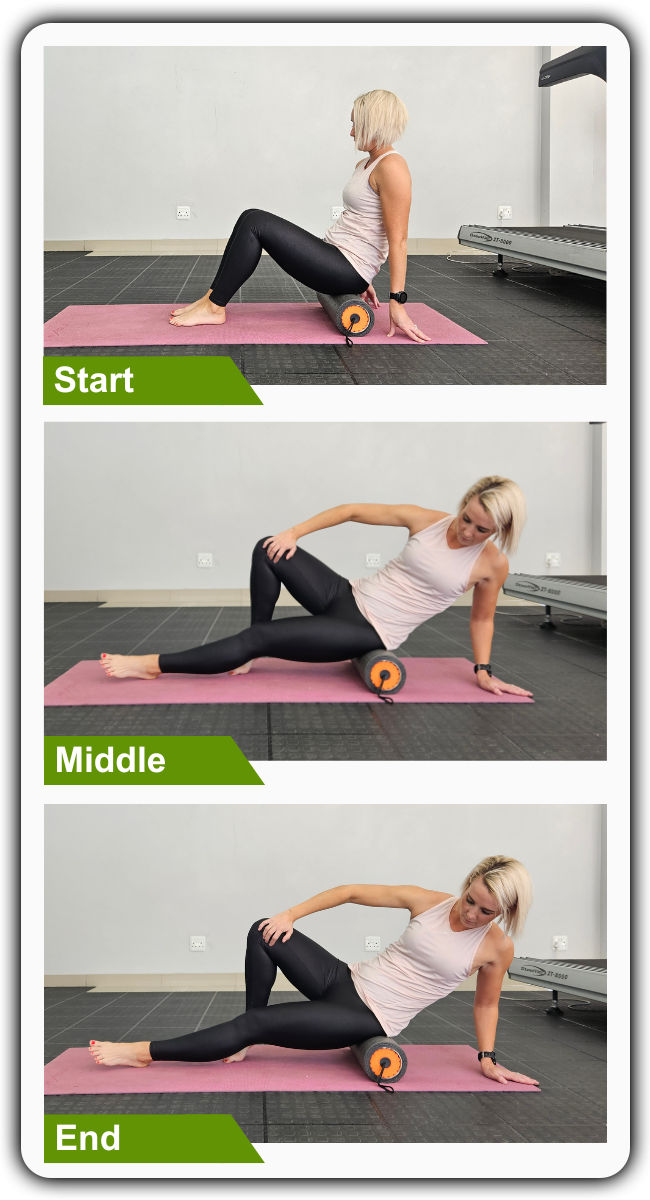
5- Chest Openers
Lie on your back on the floor with your knees bent and your feet flat on the floor. Position the foam roller under your upper back, lifting your upper body and maintaining good alignment with your head, shoulders, and hip. Place your hands by your ears or interlace your fingers behind your head. Engage your core and arch your back as you lower your head to the floor to open your chest up. Hold this position for a couple of seconds. Relax and return to the starting position.
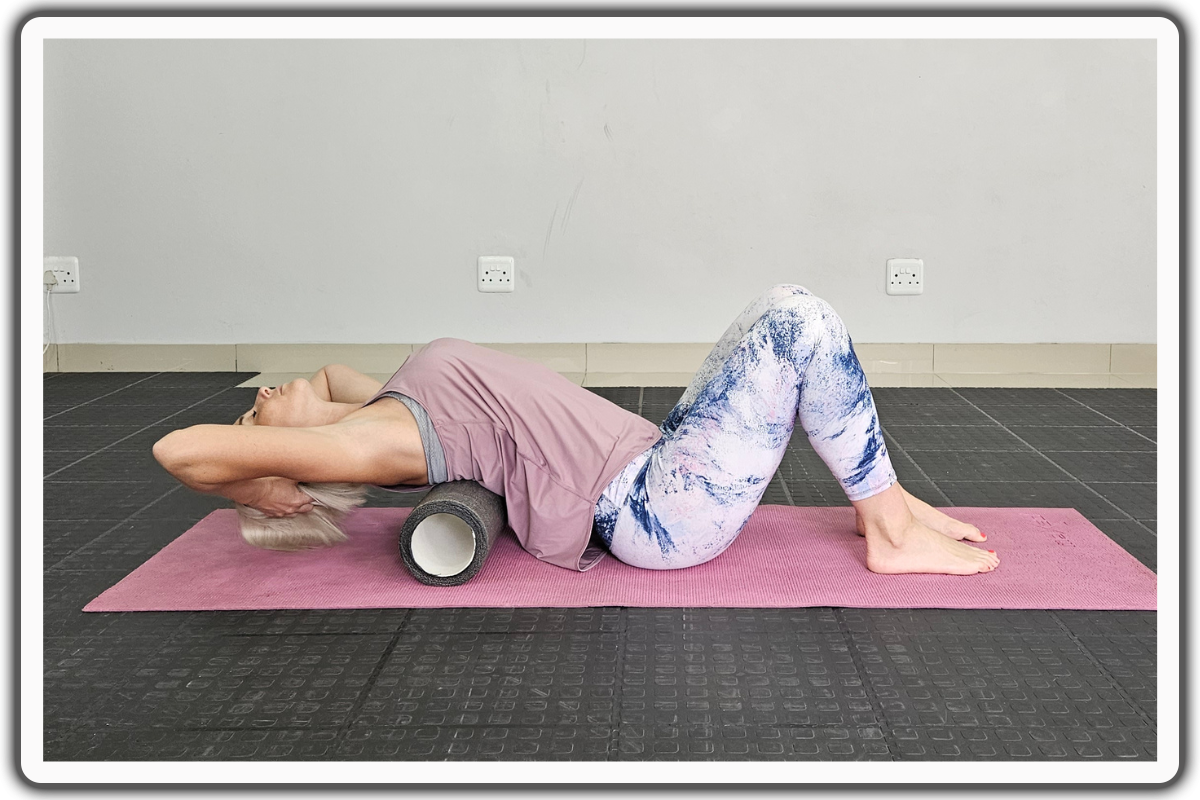
Incorporate these foam roller exercises into your routine 2-3 times per week, gradually increasing the intensity and duration as your body adapts. Listen to your body and modify the exercises to suit your comfort and pain tolerance.
Safety Tips and Best Practices
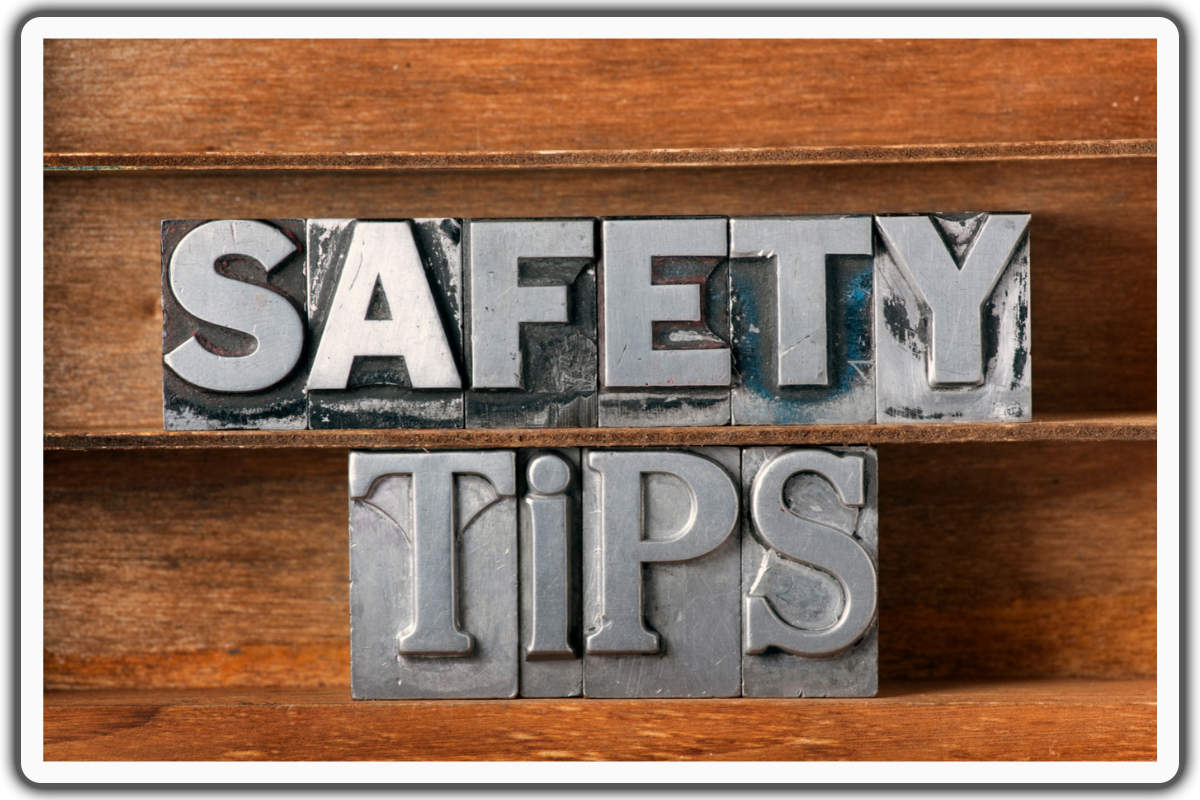
While foam rolling is a safe and effective way to manage lower back pain, there are certain precautions everyone should take to avoid injury and maximize the benefits of their practice.
When to Avoid Foam Rolling: It's essential to avoid foam rolling without consulting a healthcare professional if you have severe inflammation, acute injuries, or conditions like osteoporosis. Additionally, never foam roll directly on the lower back or spine; instead, focus on the surrounding muscles.
Listening to Your Body: Start with light pressure and only increase as tolerated. If you encounter a particularly painful spot, ease up on the pressure or avoid it altogether. The goal is to relieve tension, not cause more pain.
Rolling Too Fast: Properly using the foam roller is essential to avoid potential pitfalls and gain maximum exercise benefits. When using a foam roller, be mindful to roll correctly, whether with the foam roller perpendicular to the muscle or positioned horizontally, to ensure effective and safe muscle release.
Troubleshooting Common Issues
Foam rolling can sometimes lead to soreness, especially if you're new to the practice or have been working on a particularly tight area.
Dealing with Soreness: If you experience soreness after foam rolling, consider reducing the pressure or duration of your sessions. You can also find relief by applying ice or heat to the affected area. Ensure you're staying hydrated, and consider incorporating gentle stretching to help alleviate discomfort.
Adjusting Intensity: If foam rolling feels too intense, you can modify the exercises using a softer roller or changing your body position to reduce the weight you place on the roller. Over time, as your muscles adapt, you can handle more pressure.
Incorporating Foam Roller Exercises into Your Fitness Routine
Incorporating foam roller exercises into your regular fitness routine is crucial to reap the full benefits of lower back pain relief. Here are some tips to help you establish a successful foam rolling practice:
- Consistency: Aim to perform foam roller exercises 2-3 times weekly to experience the maximum benefits. Consistency improves flexibility, relieves muscle tension, and prevents lower back pain.
Post-Workout Routine: Foam rolling after a workout can help minimize muscle soreness and promote faster recovery. Allocate a few minutes at the end of your workout to perform the foam roller exercises targeting your lower back.
Pre-Bedtime Routine: Foam rolling before bed can help release tension and promote relaxation, preparing your body for a restful night's sleep. Incorporate foam roller exercises into your bedtime routine to help reduce lower back pain and improve sleep quality.
Start Slow: For beginners in foam rolling or those with a sensitive lower back, start with shorter durations and apply gentler pressure. Gradually increase the intensity and duration of the exercises as your body adapts and becomes more comfortable.
Listen to Your Body: Pay attention to how your body responds to the foam roller exercises. If a particular exercise causes discomfort or exacerbates your lower back pain, modify or skip it altogether. Listening to your body's signals and prioritizing your safety and well-being is essential.
By consistently incorporating foam roller exercises into your fitness routine and with proper technique, you can effectively manage lower back pain, improve spinal health, and enhance your overall well-being.
Conclusion: The Importance of Regular Foam Roller Exercises for Lower Back Health
Lower back pain is a prevalent condition that can significantly impact daily life. Fortunately, foam roller exercises provide a safe, accessible, and effective solution for managing and preventing lower back pain.
By understanding the causes of lower back pain and the benefits of foam rolling, you can target the specific muscles and areas affected by pain, promoting relief, flexibility, and strength. Incorporating foam roller exercises into your routine can improve your posture, enhance core stability, and reduce the risk of future lower back injuries.
Remember to choose the correct foam roller for your needs, prepare your body adequately, and practice proper form and breathing during the exercises. Start with the basic foam roller exercises for lower back pain relief and progress to more advanced foam rolling exercises as your strength and stability improve.
